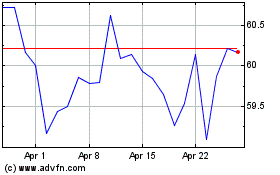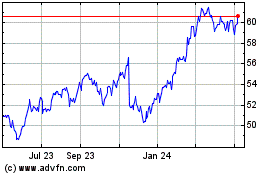By Samantha Pearson and Sarah Nassauer
SÃO PAULO -- Facing lackluster sales in the world's
fifth-largest consumer market, Wal-Mart Stores Inc. is making a
contrarian bet in Brazil, investing heavily to revamp its
U.S.-style big-box stores even as shoppers increasingly flock to
smaller, cheaper options.
Wal-Mart has said it plans to spend 1 billion reais, or some
$320 million, over three years on upgrades to its hypermarkets in
Brazil, mostly sticking with a strategy it has followed here for
two decades. Wal-Mart's net sales in the country have been sluggish
in recent years compared with its other international markets,
falling 4.1% for the three months ended Jan. 31, versus increases
for the same period of 8.9% across Mexico and Central America, and
5.4% in China.
"Ever since it entered Brazil, Wal-Mart has found it difficult
to integrate itself into the market," says Flávio Tayra, a
professor of the Federal University of São Paulo, who specializes
in food retailing. "It occupies a modest space here given all the
potential it has."
As in the U.S., Wal-Mart's main big-box stores in Brazil sell
everything from bananas to car tires. They were popular with
Brazilians during the hyperinflation of the 1980s and early 1990s,
when prices were rising at stratospheric rates. Many shoppers would
get paid, then rush to the hypermarket on the outskirts of town to
stock up before prices rose further.
Now, that mode of shopping has lost its appeal for many here.
Hellish traffic in mushrooming cities makes hypermarkets hard to
reach. Small neighborhood convenience stores are attracting
Brazilians who increasingly live alone, not in large family
homes.
Meanwhile, a newer discount retail format is attracting Brazil's
bargain-hunters: Warehouse-style stores known as "cash and carries"
-- many owned by France-based Carrefour and Groupe Casino's GPA and
originally targeted at small businesses -- sell household items and
a small selection of groceries in bulk to families at steep
discounts. Since 2015, when Brazil plunged into its worst recession
on record, cash-and-carries have become more popular. Shoppers tend
to go once a month or so to stock up on items like cleaning
products and beer and rely on neighborhood supermarkets for most
food and grocery items.
Against that trend, Wal-Mart is redoubling its focus on
hypermarkets, with investments in two regional chains, Hiper
Bompreço and BIG, which it acquired in the mid-2000s. The chains
will be rebranded with the Wal-Mart name, and existing Wal-Mart
branded big-box stores will also get a face-lift, with upgraded
fresh produce, wider overall assortment and lower prices, according
to a statement by Flavio Cotini, president of Walmart Brazil, on
the retailer's Portuguese-language website.
Some analysts say Wal-Mart's focus on hypermarkets is
ill-advised. "Focusing on a format that is clearly losing market
share and is no longer very attractive to Brazilians doesn't seem
appropriate," says Bruna Pezzin, an analyst at São Paulo-based
investment broker XP Investimentos.
Wal-Mart executives have said they see some improvement in the
Brazil operations, especially after efforts at their own
cash-and-carry chain, Maxxi Wholesales and a similar concept, Sam's
Club, which together make up less than a fifth of Wal-Mart's 500
Brazil stores. Wal-Mart in 2017 also plans to open stores under its
neighborhood-grocer brand, TodoDia, and remodel supermarkets, a
company spokesman said.
Wal-Mart doesn't disclose detailed financial statements for
Brazil and declined to comment about whether it is profitable
there. Senior management has acknowledged that Brazil is a
consistent weak spot in its 11,700-store global portfolio. The
Brazil unit has changed chief executives four times since 2008;
early last year Wal-Mart announced it would close 60 loss-making
stores in the country.
Brazil "is proving to be an increasingly challenging economic
environment," Wal-Mart chief executive Doug McMillon said last
year. Wal-Mart reported revenue in Brazil of 29.3 billion reais
($9.39 billion) for the 2015 calendar year, according to its
website, a tiny slice of its total revenue of $482.1 billion for
the fiscal year that ended in January 2016.
Wal-Mart has had difficulties in the past penetrating
international markets. It left Germany and South Korea in 2006
after failing to boost profits there.
Some analysts and former executives in Brazil say they see
Wal-Mart's renewed investment in hypermarkets as emblematic of a
U.S.-centric strategy that has led it to several highly visible
blunders in Brazil. When Wal-Mart first arrived here in the
mid-1990s, its stores raised eyebrows by trying to sell golf
equipment in a nation obsessed with soccer, and winter coats during
the southern hemisphere's summer -- issues that were "quickly
corrected," the spokesman said.
Rebranding the Hiper Bompreço and BIG chains could be especially
risky, analysts say. Both retailers have well-recognized names in
their regions -- an advantage in a recession, when shoppers tend to
gravitate to trusted local names and family-run operations.
While "Everday Low Prices" were a cornerstone of Wal-Mart's rise
to dominance in the U.S., its insistence on that type of pricing in
Brazil doesn't account for poorer shoppers' tendency to want to
cherry-pick promotional prices, said Thales Teixeira, a Harvard
Business School professor. "In the U.S., most of us will not go to
more than one supermarket in a weekend," he said. "But in Brazil,
people are more conscious about price...so they are willing to go
to multiple supermarkets."
And while an average "shopping basket" of items may consistently
cost less at Wal-Mart than at other stores, the retailer rarely
offers the lowest price for any single item, Prof. Teixeira
said.
Wal-Mart's Tamboré hypermarket on the outskirts of São Paulo was
the first store to be renovated. On a recent visit, customers
praised the brighter lighting, wider aisles and better selection of
fruits and vegetables. But few said they were regular shoppers
there. "I normally go to the Carrefour nearby but it's so chaotic,"
said Ósia Nascimento, a retired teacher, shopping with her
grandson. "I like it here, though," she said. "It's emptier."
Write to Samantha Pearson at samantha.pearson@wsj.com and Sarah
Nassauer at Sarah.Nassauer@wsj.com
(END) Dow Jones Newswires
March 13, 2017 02:47 ET (06:47 GMT)
Copyright (c) 2017 Dow Jones & Company, Inc.
Walmart (NYSE:WMT)
Historical Stock Chart
From Mar 2024 to Apr 2024

Walmart (NYSE:WMT)
Historical Stock Chart
From Apr 2023 to Apr 2024
